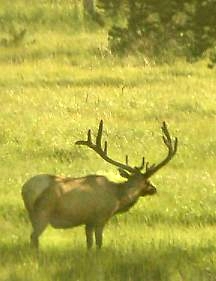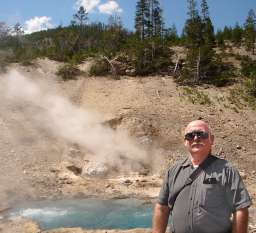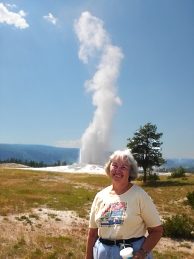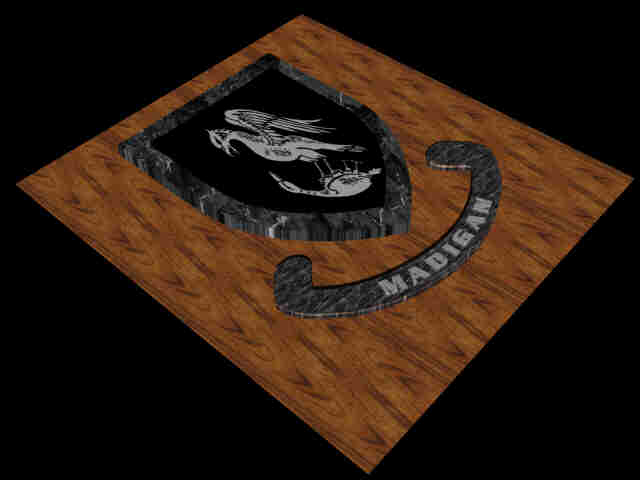Twenty-one miles later we arrive at the Norris Geyser
basin. Everything about the thermal side of the park is located in some
form in this area. At one poin t in the road, we found a place to pull off where
we could see down into the entire thermal basin. It reminded me of a
airplane view of a an old civil war encampment with all the campfires ablaze.
Each of the formally named thermal formations, hot springs, fumaroles, mudpots
and geysers, can be found in greater magnificence in other parts of the park,
but no where could we see all of them in one place. If time is not an issue,
stop by the Norris museum and learn about these phenomena, including Steamboat
Geyser, the tallest geyser in the world and Echinus Geyser, the largest
acidic geyser in the world. It was in this area that we came upon our
second NB (natural roadblock). This time the shot was worth
it. I could see well up the road and determined that we were going to be
there for a while.
t in the road, we found a place to pull off where
we could see down into the entire thermal basin. It reminded me of a
airplane view of a an old civil war encampment with all the campfires ablaze.
Each of the formally named thermal formations, hot springs, fumaroles, mudpots
and geysers, can be found in greater magnificence in other parts of the park,
but no where could we see all of them in one place. If time is not an issue,
stop by the Norris museum and learn about these phenomena, including Steamboat
Geyser, the tallest geyser in the world and Echinus Geyser, the largest
acidic geyser in the world. It was in this area that we came upon our
second NB (natural roadblock). This time the shot was worth
it. I could see well up the road and determined that we were going to be
there for a while.  From returning tourists, I learned that there was an
Elk herd off to the left. Rather then join the crowd, I found a path
leading down into the woods. Having yet to be impressed with the natural
beauty of the landscape; Yellowstone is a hot thermal area made up of rolling
hills and mountainous terrain. What hasn't been burned by fire has been
disrupted by the effects of water and magma. I would not call it
lush and green. The predominant growth is the Lodge-pole Pine. Its
claim to fame is in its pinecone which never opens until heated by a forest
fire, but more on that later. I was happily surprised to find a pleasing hike to an
open field. Again, I was surprised to find that the herd was out of sight
but that the bull, standing far off from the hard was right in front of
me. Even at the 250 some odd yards away, this big fellow was alert to me
as soon as I made my appearance in the field. As we watched each other for the
time I was there, I got the feeling that he wasn't really afraid of me, nor did
he feel threatened. It was more a male to male understanding. I ran
through my memory of trivial facts about the species. A bull Elk averages
around 700 lbs, stands 5 feet at the shoulder and is 8 feet, nose to tail.
(OK, I looked it up on the Rocky Mountain Elk Foundation's web site.) A
little incursion was tolerated but too much and who knows. I let him be the
judge and quietly slipped by him into the woods and back to the car. Norris is
the junction of the upper loop and the lower loop. We continued
south to Madison where the west entrance intersects
From returning tourists, I learned that there was an
Elk herd off to the left. Rather then join the crowd, I found a path
leading down into the woods. Having yet to be impressed with the natural
beauty of the landscape; Yellowstone is a hot thermal area made up of rolling
hills and mountainous terrain. What hasn't been burned by fire has been
disrupted by the effects of water and magma. I would not call it
lush and green. The predominant growth is the Lodge-pole Pine. Its
claim to fame is in its pinecone which never opens until heated by a forest
fire, but more on that later. I was happily surprised to find a pleasing hike to an
open field. Again, I was surprised to find that the herd was out of sight
but that the bull, standing far off from the hard was right in front of
me. Even at the 250 some odd yards away, this big fellow was alert to me
as soon as I made my appearance in the field. As we watched each other for the
time I was there, I got the feeling that he wasn't really afraid of me, nor did
he feel threatened. It was more a male to male understanding. I ran
through my memory of trivial facts about the species. A bull Elk averages
around 700 lbs, stands 5 feet at the shoulder and is 8 feet, nose to tail.
(OK, I looked it up on the Rocky Mountain Elk Foundation's web site.) A
little incursion was tolerated but too much and who knows. I let him be the
judge and quietly slipped by him into the woods and back to the car. Norris is
the junction of the upper loop and the lower loop. We continued
south to Madison where the west entrance intersects  and then on south to
the Lower Geyser Basin. This is the location of the Fountain Paint pot. Here,
again, one can see all the various thermal
displays offered, in one place. The paintpots in this area get their name
from the various hues of yellow, through red, to brown that make up the mud. In
addition, there are an ample number of hot springs and geysers, not to mention a
number of fumaroles. This is the formal name for a steam vent. These
vents appear in many place and some caution is needed as the steam reaches
temperatures around 200 degrees. The next stop on the tour was the one we
had come to see. The most famous of all geysers in all the world.
Good "Old Faithful". I had heard in the past that the area
has been blocked off and people were being bussed in from an outer parking area
such as is now done at Harper's Ferry National Park". This was not
the case. We drove right up to within a quarter mile of the geyser,
and along with several hundred other people wandered the lodge, ate in the
dinning room and relaxed in front of the big bay windows that overlook the
geyser. Then at the appropriate time we all went outside and took up
positions around the outer edge and waited. Right on time, more or less,
there was a hiss of steam, then a few gurgles and some
and then on south to
the Lower Geyser Basin. This is the location of the Fountain Paint pot. Here,
again, one can see all the various thermal
displays offered, in one place. The paintpots in this area get their name
from the various hues of yellow, through red, to brown that make up the mud. In
addition, there are an ample number of hot springs and geysers, not to mention a
number of fumaroles. This is the formal name for a steam vent. These
vents appear in many place and some caution is needed as the steam reaches
temperatures around 200 degrees. The next stop on the tour was the one we
had come to see. The most famous of all geysers in all the world.
Good "Old Faithful". I had heard in the past that the area
has been blocked off and people were being bussed in from an outer parking area
such as is now done at Harper's Ferry National Park". This was not
the case. We drove right up to within a quarter mile of the geyser,
and along with several hundred other people wandered the lodge, ate in the
dinning room and relaxed in front of the big bay windows that overlook the
geyser. Then at the appropriate time we all went outside and took up
positions around the outer edge and waited. Right on time, more or less,
there was a hiss of steam, then a few gurgles and some  sputters of water and
then the main attraction. It only lasted for about 3 minutes but it was
quite a sight. That was it. We all got up and went about our
business. But before leaving, we learned some things about
what we had seen. According to the brochure handed out by the rangers, a
geyser occurs when water seeps down through the ground until it ends up in an
area heated by the same magma which caused the volcanoes so many years ago.
Now super hot, the water would try to expand only to hit some constriction which
impeded its progress back up to the top. This force and counter force would play
out its power struggle until the water overpowered the constriction and roared
on past to erupt onto the surface as a geyser. Other publications listed a myriad
of truth and false beliefs. Notably: Old Faithful is so predictable
that you can set your watch by it. False: Old Faithful's eruption length and
height and time between eruptions varies daily and yearly. Or, The eruption
lasts less time now then it use to. False: Old Faithful blasts out between
3700 and 8400 gallons of water depending on the length of the eruption.
Nothing has been determined to indicate that this is either greater or lesser
then eruptions of years ago. Other tidbits included that just prior to an
eruption, Old Faithful's water temperature is at 204 degrees, fair warning to
any poor soul who allows this water to inadvertently rain down on him.
sputters of water and
then the main attraction. It only lasted for about 3 minutes but it was
quite a sight. That was it. We all got up and went about our
business. But before leaving, we learned some things about
what we had seen. According to the brochure handed out by the rangers, a
geyser occurs when water seeps down through the ground until it ends up in an
area heated by the same magma which caused the volcanoes so many years ago.
Now super hot, the water would try to expand only to hit some constriction which
impeded its progress back up to the top. This force and counter force would play
out its power struggle until the water overpowered the constriction and roared
on past to erupt onto the surface as a geyser. Other publications listed a myriad
of truth and false beliefs. Notably: Old Faithful is so predictable
that you can set your watch by it. False: Old Faithful's eruption length and
height and time between eruptions varies daily and yearly. Or, The eruption
lasts less time now then it use to. False: Old Faithful blasts out between
3700 and 8400 gallons of water depending on the length of the eruption.
Nothing has been determined to indicate that this is either greater or lesser
then eruptions of years ago. Other tidbits included that just prior to an
eruption, Old Faithful's water temperature is at 204 degrees, fair warning to
any poor soul who allows this water to inadvertently rain down on him.
 <<<<< Back
HOME PAGE >>>>>
Next
<<<<< Back
HOME PAGE >>>>>
Next 